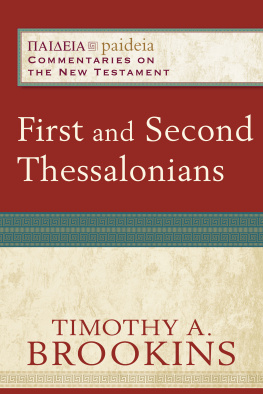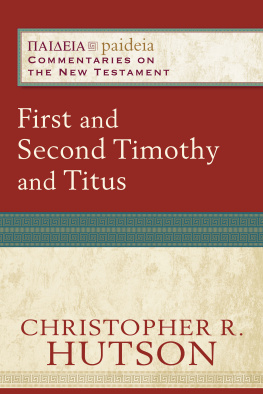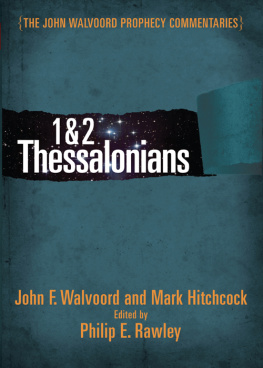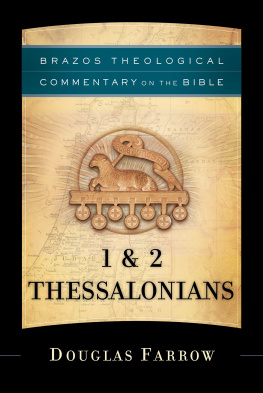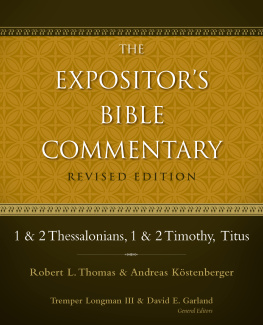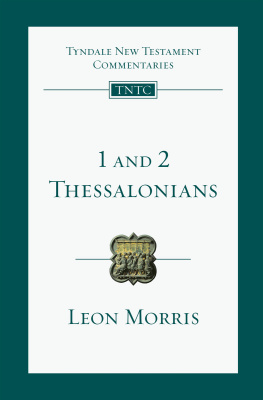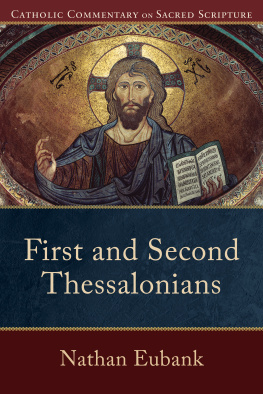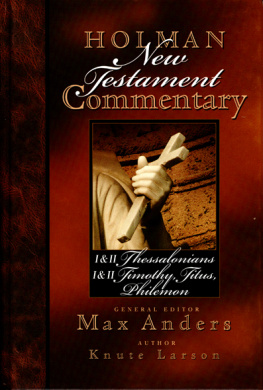Timothy A. Brookins - First and Second Thessalonians
Here you can read online Timothy A. Brookins - First and Second Thessalonians full text of the book (entire story) in english for free. Download pdf and epub, get meaning, cover and reviews about this ebook. year: 2021, publisher: Baker Publishing Group, genre: Religion. Description of the work, (preface) as well as reviews are available. Best literature library LitArk.com created for fans of good reading and offers a wide selection of genres:
Romance novel
Science fiction
Adventure
Detective
Science
History
Home and family
Prose
Art
Politics
Computer
Non-fiction
Religion
Business
Children
Humor
Choose a favorite category and find really read worthwhile books. Enjoy immersion in the world of imagination, feel the emotions of the characters or learn something new for yourself, make an fascinating discovery.
- Book:First and Second Thessalonians
- Author:
- Publisher:Baker Publishing Group
- Genre:
- Year:2021
- Rating:5 / 5
- Favourites:Add to favourites
- Your mark:
- 100
- 1
- 2
- 3
- 4
- 5
First and Second Thessalonians: summary, description and annotation
We offer to read an annotation, description, summary or preface (depends on what the author of the book "First and Second Thessalonians" wrote himself). If you haven't found the necessary information about the book — write in the comments, we will try to find it.
First and Second Thessalonians — read online for free the complete book (whole text) full work
Below is the text of the book, divided by pages. System saving the place of the last page read, allows you to conveniently read the book "First and Second Thessalonians" online for free, without having to search again every time where you left off. Put a bookmark, and you can go to the page where you finished reading at any time.
Font size:
Interval:
Bookmark:

G ENERAL E DITORS
Mikeal C. Parsons, Charles H. Talbert, and Bruce W. Longenecker
A DVISORY B OARD
Paul J. Achtemeier
Loveday Alexander
C. Clifton Black
Susan R. Garrett
Francis J. Moloney
2021 by Timothy A. Brookins
Published by Baker Academic
a division of Baker Publishing Group
PO Box 6287, Grand Rapids, MI 49516-6287
www.bakeracademic.com
Ebook edition created 2021
All rights reserved. No part of this publication may be reproduced, stored in a retrieval system, or transmitted in any form or by any meansfor example, electronic, photocopy, recordingwithout the prior written permission of the publisher. The only exception is brief quotations in printed reviews.
Library of Congress Cataloging-in-Publication Data is on file at the Library of Congress, Washington, DC.
ISBN 978-1-4934-3215-8
Unless otherwise indicated, all Scripture quotations are the authors translation.
Scripture quotations labeled NRSV are from the New Revised Standard Version of the Bible, copyright 1989 National Council of the Churches of Christ in the United States of America. Used by permission. All rights reserved.
Baker Publishing Group publications use paper produced from sustainable forestry practices and post-consumer waste whenever possible.
To my beloved children
Adam, Ryan, and Caitlin

Half Title Page
Series Page
Title Page
Copyright Page
Dedication
List of Figures and Tables
Foreword
Preface
Abbreviations
1 Thessalonians
Introduction to 1 Thessalonians
1 Thessalonians 1:110: Letter Opening
1 Thessalonians 2:112: Pauls Ministry in Thessalonica
1 Thessalonians 2:1316: Renewed Thanksgiving
1 Thessalonians 2:173:13: Pauls Desire to Visit Again
1 Thessalonians 4:112: Exhortation, Part 1
1 Thessalonians 4:135:11: Exhortation, Part 2
1 Thessalonians 5:1222: Final Exhortations
1 Thessalonians 5:2328: Letter Closing
2 Thessalonians
Introduction to 2 Thessalonians
2 Thessalonians 1:112: Letter Opening
2 Thessalonians 2:13:5: Letter Body
2 Thessalonians 3:615: Final Exhortation: Admonition against Irresponsible Living
2 Thessalonians 3:1618: Letter Closing
Bibliography
Index of Subjects
Index of Modern Authors
Index of Scripture and Ancient Sources
Back Cover

Figures
- Fragment from the Earliest Copy of 1 Thessalonians ()
- Pauls Macedonian Ministry
- Thessalonica and Mediterranean Travel
- A Votive to the God Osiris
- News of the Thessalonians following the Founding Visit
- Travel Routes before and after the Founding Visit
- Roman Coin Featuring Julius Caesar and Octavian
- Roman Coin Featuring Emperor Claudius and Roman Peace
Tables
- The Parallel Relations in 1 Thess. 4:1112
- The First-Person Plural and Exhortation in 1 Thess. 5:810
- The Structural Symmetry of 1 Thess. 5:1215
- Pauls Appeals in 1 Thess. 5:1213 and 1 Cor. 16:1518
- The Parallel Structure of 1 Thess. 5:1213; 5:14; and 5:1618
- Synopsis of Structural Parallels between 1 and 2 Thessalonians
- Other Verbal Similarities between 1 and 2 Thessalonians
- The Thanksgiving Sections in 1 and 2 Thessalonians
- The Antitheses between Believers and Nonbelievers
- The Lord Jesus and the Man of Lawlessness Compared
- Contrast between Paul and the Ataktoi
- 2 Thess. 3:1415 and 1 Cor. 5:111 Compared

Paideia: Commentaries on the New Testament is a series that sets out to comment on the final form of the New Testament text in a way that pays due attention both to the cultural, literary, and theological settings in which the text took form and to the interests of the contemporary readers to whom the commentaries are addressed. This series is aimed squarely at studentsincluding MA students in religious and theological studies programs, seminarians, and upper-division undergraduateswho have theological interests in the biblical text. Thus, the didactic aim of the series is to enable students to understand each book of the New Testament as a literary whole rooted in a particular ancient setting and related to its context within the New Testament.
The name Paideia (Greek for education) reflects (1) the instructional aim of the seriesgiving contemporary students a basic grounding in academic New Testament studies by guiding their engagement with New Testament texts; (2) the fact that the New Testament texts as literary unities are shaped by the educational categories and ideas (rhetorical, narratological, etc.) of their ancient writers and readers; and (3) the pedagogical aims of the texts themselvestheir central aim being not simply to impart information but to form the theological convictions and moral habits of their readers.
Each commentary deals with the text in terms of larger rhetorical units; these are not verse-by-verse commentaries. This series thus stands within the stream of recent commentaries that attend to the final form of the text. Such reader-centered literary approaches are inherently more accessible to liberal arts students without extensive linguistic and historical-critical preparation than older exegetical approaches, but within the reader-centered world the sanest practitioners have paid careful attention to the extratext of the original readers, including not only these readers knowledge of the geography, history, and other contextual elements reflected in the text but also their ability to respond correctly to the literary and rhetorical conventions used in the text. Paideia commentaries pay deliberate attention to this extratextual repertoire in order to highlight the ways in which the text is designed to persuade and move its readers. Each rhetorical unit is explored from three angles: (1) introductory matters; (2) tracing the train of thought or narrative or rhetorical flow of the argument; and (3) theological issues raised by the text that are of interest to the contemporary Christian. Thus, the primary focus remains on the text and not its historical context or its interpretation in the secondary literature.
Our authors represent a variety of confessional points of view: Protestant, Catholic, and Orthodox. What they share, beyond being New Testament scholars of national and international repute, is a commitment to reading the biblical text as theological documents within their ancient contexts. Working within the broad parameters described here, each author brings his or her own considerable exegetical talents and deep theological commitments to the task of laying bare the interpretation of Scripture for the faith and practice of Gods people everywhere.
Mikeal C. Parsons
Charles H. Talbert
Bruce W. Longenecker

The letters of 1 and 2 Thessalonians are truly underappreciated. In any case, that is the opinion I have come to the more I have studied them. These letters are perhaps best known for their attention to the end timesthe resurrection of believers, the return of Jesus, and the coming of the Antichrist. A deeper dive into these letters, however, reveals that their significance extends far beyond their discussion of such themes. In addition to their treatment of practical issues like sex and unemployment, they offer us a valuable window into the troubled beginnings of one of historys oldest churches, and into the strategies of pastoral care that Paul used to encourage and exhort them in his absence, as they faced persecution so soon after their conversion. It is hoped that the painstaking work of historical and textual analysis that went into this commentary will increase appreciation of these letters in the one who reads it, just as it did in me in writing it.
Font size:
Interval:
Bookmark:
Similar books «First and Second Thessalonians»
Look at similar books to First and Second Thessalonians. We have selected literature similar in name and meaning in the hope of providing readers with more options to find new, interesting, not yet read works.
Discussion, reviews of the book First and Second Thessalonians and just readers' own opinions. Leave your comments, write what you think about the work, its meaning or the main characters. Specify what exactly you liked and what you didn't like, and why you think so.

